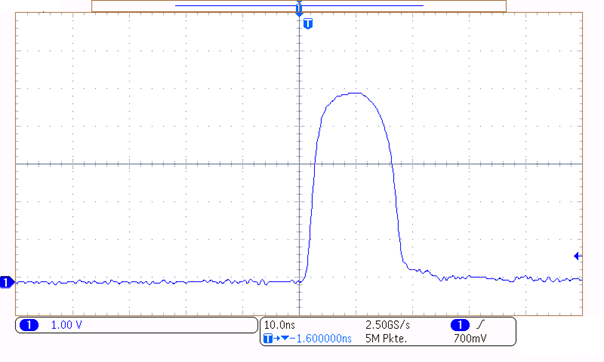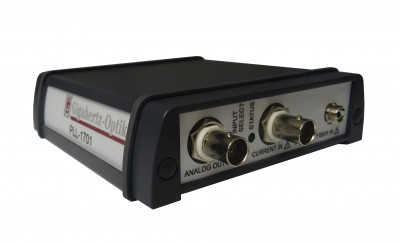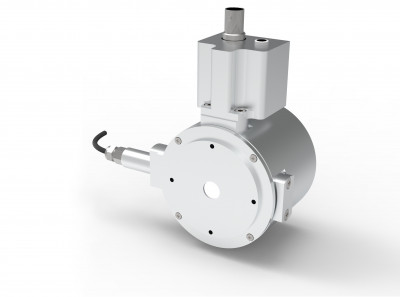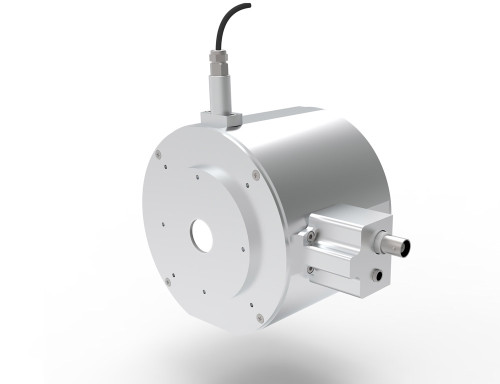
High Speed Integrating Spheres and Detectors for Pulse Energy and Pulse Waveform Measurement of Lasers/VCSELs
LiDAR technology is being actively used in an increasing number of different applications, ranging from automotive, airborne topographic mapping, and security to agriculture and industry. Most of these applications require laser diodes emitting short pulses (down to ns) with peak powers of several Watts or even kW in order to allow high spatial LiDAR measurement solutions and long detection range. Especially new technologies like flash LiDAR systems are based on time-of-flight measurements, with the benefit that they do not require beam scanners because only one short laser pulse with a large divergence is used to cover the whole scene. The depth of encountered objects can then be immediately recovered from measurement of the echoed light, hence enabling real-time 3D mapping of the environment [1].
For such tasks a frequently used type of semiconductor technology is the Vertical Cavity Surface Emitting Laser (VCSEL). These typically show an elliptical beam profile with high divergence which might be adapted by the use of optics in front of the laser diode. In order to perform a full temporal characterization of VCSELs - and hence these kinds of LiDAR sources-, the average power alone is not sufficient. Also, properties like pulse width, pulse shape, pulse frequency and peak power are important.
Pulse Width
The pulse width corresponds to the target spatial resolution (vertical or horizontal, depending on the scanning trajectory). Shorter pulses result in a higher spatial resolution and hence are in general desirable. However, the detector part must be able to process such short pulses and the typically resulting low signals.
Pulse Shape
The most important parameter here is that the pulse is Gaussian shaped. If any different pulse shape occurs, results from the LiDAR will be non-reliable (see [2]). E.g. if the pulse is showing a double peak due to an error in control electronics, the LiDAR’s measurements will have higher uncertainties.
Pulse Frequency/Pulse Repetition Rate
In order to increase the sampling rate of a LiDAR system without reducing scanning speed, increasing the repetition rate of the pulses is a smart option. Systems have evolved from the kHz range in the past to the MHz range in the present.
Peak power
Higher peak power results in stronger reflected signals and therefore enables a greater measurement distance of the LiDAR system. Another effect is that even low reflecting materials/objects can be detected. This results in high peak powers being the goal. However, eye safety still needs to be guaranteed which limits the maximum which can be used for most applications.
Classical Laser Power Measurement
For the classical measurements of average power and pulse energy, please see to our article about Laser Power Measurements (see App. 42).
High-Speed Lasers Measurement
Gigahertz-Optik offers different kind of measurement solutions for the mentioned high-speed lasers covering the wavelength range from 200 nm – 1800 nm which includes the mainly used wavelengths such as 532 nm, 905 nm, 940 nm, 1064 nm and 1550 nm. Furthermore, we are able to offer solutions for different mechanical sizes, beam profiles, time domains or even customized solutions including traceable calibrations with lowest calibration uncertainties.
1550 nm offers a potentially “eye safe wavelength” for LiDAR devices (see DIN 60825 and [3]) as well as cost efficient high powers. In addition, it is of advantage in foggy situations since it is less absorbed by water. As a result, this wavelength is becoming more and more relevant. However, the detector technology is more challenging since InGaAs sensors are needed which usually come along with less pixels and resolution. 532 nm is e.g. typically used for mapping the bottom of the sea since its transmission in water is far less compared to higher wavelengths and for this application a visible laser is acceptable which is not the case for autonomous cars. Nevertheless, 1064 nm so far is the most used wavelength at the moment. Reasons are that it is still in the Si sensor range with all its advantages.
Our strengths at a glance for Laser Characterization
- Accurate and traceable laser power/energy measurement
- Pulse characteristics / pulse waveform
- Laser spectrum by external spectroradiometer
- Range of products for different geometries, divergence, etc. of laser
In the following sections, we show a product selection from our standard product catalog, starting with a small all-in-one device with medium scanning frequency and incorporating an integrating sphere up to ultra-fast integrating sphere systems with different diameters. We offer customized solutions as well. Please contact us!
High Speed combined Integrating Spheres and external Detector System (up to 21 kHz)
If pulse widths are in the range of microseconds (µs) or milliseconds (ms), a directly ISO 17025 traceable radiometric power measurement and characterization of the waveform is possible with a single photodiode setup.
For this, Gigahertz-Optik developed a high speed transimpedance amplifier with a rise time of down to 16 µs, called the PLL-1701. This corresponds to a bandwidth of 21 kHz for the measurement.

The PLL-1701 can be used with external detectors by its BNC-connector to be compatible to the full range of Gigahertz-Optik’s light measurement detectors. Furthermore, it offers a direct FC fiber input with an incorporated small integrating sphere. The diode mounted to the sphere covers the wavelength range from 400 nm – 1550 nm and hence does also include all relevant laser wavelengths. This means fiber-coupled sources or lasers which can be coupled into the sphere directly in a free space setup can directly be measured without any further accessories.
External detectors as well as the internal integrating sphere can be read out using a linear and also a logarithmic amplifier. The single stage logarithmic amplifier enables the PLL-1701 to measure high dynamic signals without the need to switch ranges. The advantages of the linear amplifier are its superb linearity and high dynamic range which is offered by multiple gain ranges. With this flexibility, the PLL-1701 provides traceable results for many different kinds of applications, covering a large wavelength range s and selection of pulse properties.
High Speed Integrating Spheres with Two-Diode-Technology (up to 0.1 GHz)
For ultra-short pulses and pulse lengths in the low ns-range (e.g. 8 ns), a direct measurement of pulse shape (waveform) and radiometric pulse power (W) with one photodiode is not possible since there are no suitable photodiodes available. The limit is basically given by the rise time of transimpedance amplifiers (usually low microsecond range) in combination with the response time and responsivity of the photodiode.
Small photodiodes (active area) offer a very short response time, but need high amplification in order to generate signals which can be measured. This usually results in a large noise if the transimpedance amplifier is as fast as the photodiode or slower transimpedance amplifiers are used to reduce the noise. Neither is satisfactory for addressing the needs of the application.
To overcome this limitation, we offer our so called Two-Diode-Technology high speed integrating spheres. This means two separate photodiodes are mounted on a single integrating sphere.
An ISO 17025 calibrated photodiode measures the pulse energy by using the pulse-stretching method (see App. 42). This allows accurate laser power and laser energy measurements with low noise.
In addition, a small fast photodiode with rise-times in the ns range is used, which measures the relative signal shape (waveform) of the incoming light offering a 50 Ohm BNC output for using an oscilloscope or other amplifiers. By combining this temporal profile with the absolute result of the first photodiode, the absolute pulse shape can be determined mathematically and therefore the pulse can be fully characterized with such a system.
Gigahertz-Optik introduced its ISD-xx-SP (SP = Shape and Power) product family for this purpose. It contains integrating spheres with different sizes (Standard products range from 16 mm to 100mm diameter) which are equipped with the previously mentioned Two-Diode-Technology to fully characterize short pulses, as well divergent laser pulses. Different sphere sizes as well as input ports help to cover all kind of sizes as well as FOVs of laser diodes.

16 mm Barium Sulfate integrating sphere with 5 mm or 7 mm input port. The 7 mm entrance port is needed if eye safety evaluations in accordance to are performed). The whole system is based on a precision machined compact CNC housing. In addition, two SMA outputs for e.g. spectral measurements are offered (see our Spectral Light Meters, UV-VIS-NIR Spectroradiometers) . Customized adaptions are possible on request.

50 mm ODM98 integrating sphere with 10 mm input port for applications with medium sized laser diameters. Third port configurable with different options like another detector or fiber outputs for spectral measurements (see our Spectral Light Meters, UV-VIS-NIR Spectroradiometers).

100 mm ODM98 integrating sphere with 20 mm input port for applications for large light source diameters. Third port configurable with different options like another detector or fiber output for spectral measurements (see our Spectral Light Meters, UV-VIS-NIR Spectroradiometers).
In order to support you with a suitable detector to characterize your pulsed laser sources, please get in contact with us. We offer over more than 25 years’ experience in integrating sphere design and light/laser-measurements and can support you in finding the correct detector setup suitable for your application or work with you on your perfect affordable customized solution.
Calibration
For any kind of radiometric laser power measurement, the calibration plays a key role in the accuracy of the final result. In other words, a low calibration uncertainty which you can trust is important. In that respect we offer calibrations from our DAkkS ISO 17025 accredited calibration and testing laboratory. This means highest standards according to the ISO 17025 are applied to the processes to ensure reliability and traceability of our calibrations. All calibrations are directly traceable to the PTB, the German NMI, or comparable NMIs. Our calibration laboratory covers the wavelength range from 200 nm – 2500 nm.
References
[1] SPIE Novel Short-Puls Laser Light Source
[2] Effect of pulse-shape uncertainty on the accuracy of deconvolved lidar profiles
[3] Eye-safe laser illuminators for long-reach Lidar and gated imaging in harsh weather conditions